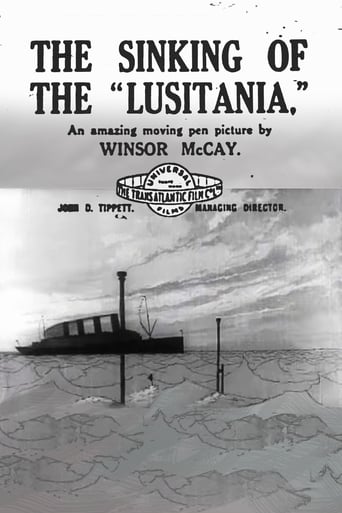Dorathen
Better Late Then Never
Borgarkeri
A bit overrated, but still an amazing film
Afouotos
Although it has its amusing moments, in eneral the plot does not convince.
Hayleigh Joseph
This is ultimately a movie about the very bad things that can happen when we don't address our unease, when we just try to brush it off, whether that's to fit in or to preserve our self-image.
Horst in Translation (filmreviews@web.de)
"The Sinking of the Lusitania" is a black-and-white silent film from 1918, so it will have its 100th anniversary in two years from now. The writer and director is Winsor McCay and if you know a bit about film history, then you will know that he one of the pioneers when it comes to animation. As groundbreaking as some of his early works may have been, this one here is where he really shines because it is about a very important event that happened during World War I, namely the sinking of the majestic ship Lusitania by the German forces. This film does not only use animation to bring across his message, it is also very informative including intertitles that describe what happened or also lists some famous names that drowned because of the sinking. Of course, there is certainly some fiction in this film as well, but I still believe it is very much worth watching and for me it is a contender for McCay's best work. I do recommend the watch.
Snow Leopard
Animation pioneer Winsor McCay applies all his considerable skills in this feature, creating a detailed and memorable account of the sinking of the Lusitania. The technique still looks quite good, and it really brings the events to life. It must have been quite effective in its time.There are lots of details that not only are carefully rendered, but that also are used effectively to add to the overall effect. It both communicates the factual details and brings out the horrors of the situation as well as any short feature could do. The events seem to be depicted with great care and accuracy, and only the strongly-worded commentary on a few of title cards reveals the creator's viewpoint. (It doesn't detract from the fine quality of this movie, but it's always unfortunate when entire nations of people are condemned for the barbarous or irresponsible actions of some of their leaders. It's understandable, of course, but unfortunate.)The Lusitania sinking was one of the most notorious events in a century that saw more than enough of them. This carefully crafted movie does its job in preserving both what happened and the response to it.
Puppetmister
Animation historians must view this film immediately, but I suppose if you can find one McCay cartoon you can find them all - they're compiled on the 'Animation Legend' video and DVD. 'Lusitania' is the film where McCay tries to escape the caricatural confines of the animated picture to produce a serious and moving film, and damn, he succeeds. The meticulous care which he put into the thousands of drawings necessary for this short cartoon meant that by the time it was finished, it was barely topical and WWI was over, leaving its calls for vengeance somewhat stranded. However, as a study of technique it is perhaps unsurpassed. McCay's animation has a dimensionality which is worlds apart from the character animation of Koko the Klown or Felix the Cat, perhaps a deliberate differentiation from such gentle entertainments. The grim monochrome images of the Lusitania's stern raised in the air while hundreds of people leap to their deaths while remind most audiences of shots from James Cameron's 'Titanic'. While the barely-concealed rage and maudlin tributes to the famous noblemen who died in the sinking (as opposed the penniless plebs who we can afford to forget) now appear unpalatably heavy-handed, the elegant curls of smoke from the stricken vessel are simply powerful cinematic touches which seal McCay's reputation as one of the great film artists of the silent era. If only he, and not Disney, had become the template for the future of American animation...
Lisa Wall
One of the best, if not the very best, animated film I have ever seen. It is not a typical animated film. It is a very impressive film on a very tragic event. Beware, it may not be for small children. I recommend this film for anyone interested in history or animation. Winsor McCay best effort. You must see this film.

